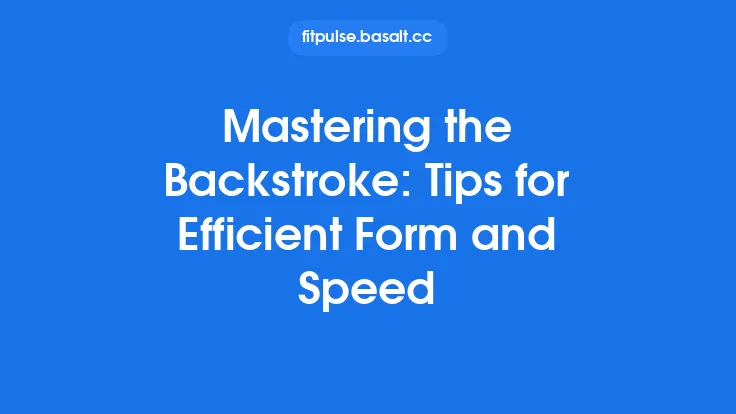Swimming is a unique cardiovascular modality because the medium—water—adds a layer of physics that profoundly influences how the body moves. Unlike land‑based activities, every motion in the pool must contend with fluid resistance, buoyancy, and the need to generate propulsion while maintaining a streamlined position. Mastering the mechanics of each competitive stroke—freestyle, backstroke, breaststroke, and butterfly—allows swimmers to reduce drag, increase thrust, and ultimately improve efficiency, which translates directly into faster times and lower energy expenditure.
Fundamentals of Hydrodynamics in Swimming
Drag Components
Drag is the primary force that opposes forward motion in water. It can be broken down into three main components:
- Form Drag – caused by the shape of the swimmer’s body and the frontal area presented to the flow. A streamlined torso, low head position, and tight core alignment minimize this.
- Friction Drag – generated by the viscosity of water sliding over the skin. While swimmers cannot eliminate it, smooth skin, proper body hair management, and a relaxed glide reduce its impact.
- Wave Drag – appears when a swimmer’s head breaks the surface, creating a bow wave. Maintaining a horizontal line and limiting vertical oscillations keep wave drag low, especially at speeds above 1.8 m·s⁻¹.
Propulsion Mechanics
Propulsion is produced by two primary actions: the arm pull (or “catch‑pull‑recovery” cycle) and the leg kick. The arm generates the majority of thrust in freestyle, backstroke, and butterfly, while the breaststroke relies heavily on the simultaneous leg kick. Effective propulsion follows Newton’s third law: water is accelerated backward, and the swimmer moves forward.
Buoyancy and Body Position
The human body is naturally slightly positively buoyant in the chest and head region, and negatively buoyant in the hips and legs. Achieving a neutral buoyancy line—where the hips sit just at the water’s surface—optimizes the balance between lift and drag. Core engagement and proper breathing technique are essential to maintain this line throughout each stroke cycle.
Freestyle (Front Crawl) Mechanics
Body Alignment
- Head Position: The eyes should look slightly forward and down, with the waterline at the top of the forehead. This keeps the neck neutral and reduces form drag.
- Hip and Leg Position: Hips should remain high; a slight “kick” from the hips, not just the knees, maintains a streamlined profile.
Arm Cycle
- Entry & Catch: The hand enters the water fingertips first, extending fully ahead of the shoulder. The catch begins as the hand rotates outward, creating a “Y‑shape” with the forearm and hand to maximize surface area.
- Pull: The hand sweeps under the body in a high‑elbow position, following a slightly S‑shaped path. The forearm acts as a paddle, while the biceps and latissimus dorsi generate the pulling force.
- Push: The hand pushes backward past the hip, aligning the forearm with the torso to maintain a straight line of force.
- Recovery: The elbow leads the hand out of the water, rotating the arm over the surface in a relaxed, relaxed “thumb‑first” motion.
Kick
A six‑to‑eight‑beat flutter kick provides continuous propulsion and stabilizes the body. The kick originates from the hips, with a slight knee flex and ankle plantarflexion to create a narrow, efficient blade.
Breathing Integration
Side breathing should be timed to the opposite arm’s recovery phase, allowing the head to rotate minimally. Inhaling with the mouth just above the water surface and exhaling continuously through the nose or mouth underwater maintains a steady rhythm and prevents torso rotation that would increase drag.
Key Efficiency Enhancements
- High Elbow Catch: Emphasize a 90° elbow during the pull to increase the effective surface area.
- Hip Roll: A subtle roll of the hips (≈10–15°) assists the arm’s entry and reduces shoulder strain.
- Streamline Push‑Off: After each turn, maintain a tight streamline (arms extended, biceps against ears) to capitalize on the glide phase.
Backstroke Mechanics
Body Alignment
- Head Position: The head remains still, with the ears in line with the shoulders and eyes looking upward. This keeps the hips high and reduces form drag.
- Hip Rotation: Similar to freestyle, a gentle roll of the hips (≈10°) assists the arm’s entry and exit.
Arm Cycle
- Entry: The hand enters the water pinky‑first, extending fully ahead of the shoulder. The arm remains straight, creating a narrow entry angle.
- Catch: The hand rotates outward, forming a “Y” with the forearm and hand. The elbow begins to bend as the hand pulls under the body.
- Pull: The elbow stays high, and the hand sweeps outward and backward in a semi‑circular path, generating thrust.
- Push: The hand pushes past the hip, aligning the forearm with the torso.
- Recovery: The arm exits the water thumb‑first, rotating over the surface with a relaxed, straight arm.
Kick
A steady, alternating flutter kick mirrors the arm rhythm. The kick should be narrow, with the ankle flexed to create a small, efficient blade. The kick’s primary role is to maintain body position and provide supplemental propulsion.
Breathing
Since the face remains out of the water, breathing is continuous. However, swimmers must avoid excessive head lift, which can cause the hips to drop and increase drag.
Key Efficiency Enhancements
- Straight Arm Entry: Reduces splash and minimizes form drag.
- Consistent Hip Roll: Facilitates a smoother arm pull and reduces shoulder strain.
- Tight Core Engagement: Keeps the hips at the surface, preventing a “sagging” posture.
Breaststroke Mechanics
Body Alignment
Breaststroke is the most “upright” of the four strokes, making drag management critical. The swimmer should aim for a flat, horizontal line during the glide phase, with the head in line with the spine.
Arm Cycle
- Out‑Sweep: Hands extend forward, palms outward, and sweep laterally just below the surface.
- Catch: The hands turn inward, creating a “heart‑shape” catch that maximizes surface area.
- Pull: The elbows bend, and the hands pull inward toward the chest, generating forward thrust.
- Recovery: Hands shoot forward together, extending fully before the next glide.
Kick (Whip or Frog Kick)
- Recovery: Knees bend, heels draw toward the buttocks, and the feet turn outward.
- Propulsion: The legs snap outward and backward in a circular motion, with the feet flexed to create a powerful “propeller” effect.
- Glide: After the kick, the legs straighten, and the swimmer assumes a streamlined position.
Timing and Coordination
The hallmark of an efficient breaststroke is the “pull‑kick‑glide” sequence. The glide should be maximized without sacrificing speed; a typical ratio is 1:1:1 (pull: kick: glide) for elite swimmers, but beginners may start with a 1:1:2 ratio to emphasize technique.
Key Efficiency Enhancements
- Symmetrical Arm Pull: Ensures balanced propulsion and reduces yaw.
- Compact Kick: A narrow, fast whip minimizes drag and maximizes thrust.
- Long Glide: Maintaining a tight streamline after the kick conserves momentum.
Butterfly Mechanics
Body Alignment
Butterfly demands a strong, undulating body wave that originates from the chest and travels through the hips to the feet. The head should stay low, with the eyes looking forward and slightly down, preserving a streamlined torso.
Arm Cycle
- Entry: Hands enter the water shoulder‑width apart, thumbs first, with elbows slightly flexed.
- Catch: The hands sweep outward and downward, forming a “Y” shape that captures water.
- Pull: The elbows rise while the hands pull back under the chest, creating a powerful “keyhole” path.
- Push: Hands push backward past the hips, aligning the forearms with the torso.
- Recovery: Both arms recover simultaneously over the water in a circular motion, exiting thumb‑first.
Kick (Dolphin Kick)
The dolphin kick is a simultaneous, undulating motion of both legs. Power originates from the hips, with a slight knee flex and ankle plantarflexion. The kick is typically performed in a 2‑kick per stroke pattern: one kick during the arm pull and a second kick during the recovery phase.
Breathing
Breathing occurs during the arm pull, usually after the hands have passed the hips. The head lifts just enough for the mouth to clear the water, then returns quickly to the streamlined position to minimize drag.
Key Efficiency Enhancements
- Wave Motion: A smooth, rhythmic body wave reduces resistance and synchronizes the kick with the arm pull.
- High Elbow Catch: Maximizes surface area during the pull.
- Compact Recovery: Keeping the arms close to the surface reduces the time spent out of the water, preserving forward momentum.
Integrating Drills for Stroke Efficiency
| Stroke | Drill | Primary Mechanical Focus |
|---|---|---|
| Freestyle | Catch‑Up Drill | Emphasizes full extension and high‑elbow catch |
| Freestyle | fingertip Drag | Reinforces relaxed hand entry and proper forearm rotation |
| Backstroke | Single‑Arm Backstroke | Isolates body roll and hip rotation |
| Breaststroke | 2‑Kick 1‑Pull | Teaches proper timing between kick and glide |
| Breaststroke | Sculling | Improves feel for water and hand positioning |
| Butterfly | 3‑Kick Butterfly | Develops rhythm and body wave control |
| Butterfly | Butterfly with Dolphin Kick Only | Isolates kick mechanics and hip drive |
Incorporating these drills into a regular training routine—typically 10–15 % of total yardage—allows swimmers to focus on specific mechanical elements without the fatigue of full‑stroke swimming. Repetition under low‑intensity conditions builds neuromuscular patterns that translate into smoother, more efficient strokes during race‑pace efforts.
Monitoring Progress and Adjusting Technique
Video Analysis
High‑speed underwater cameras provide visual feedback on hand entry angles, elbow height, and body roll. Comparing footage across sessions highlights subtle improvements or regressions.
Force Plate or Pressure Sensors
When available, hand‑mounted pressure sensors quantify the distribution of force during the pull phase, helping swimmers identify whether they are “grabbing” water effectively.
Physiological Markers
A decrease in perceived exertion (RPE) at a given pace, or a lower heart‑rate for the same speed, indicates improved mechanical efficiency. Tracking these metrics alongside stroke count (strokes per length) offers a quantitative measure of progress.
Iterative Adjustment Cycle
- Assess – Use video/tech tools to identify inefficiencies.
- Target – Choose a specific drill or cue to address the issue.
- Implement – Integrate the drill into a focused set (e.g., 8 × 25 m with 20 s rest).
- Re‑evaluate – Re‑record or re‑measure after a week of practice.
- Refine – Adjust cues or drill volume based on observed changes.
Closing Thoughts
Efficiency in swimming is the product of precise biomechanics, disciplined body awareness, and consistent technical refinement. By dissecting each stroke into its constituent phases—entry, catch, pull, push, recovery, and kick—athletes can pinpoint where drag is generated and where thrust can be amplified. Applying targeted drills, leveraging video feedback, and monitoring physiological responses create a feedback loop that drives continual improvement. Mastery of these mechanics not only yields faster times but also reduces the energy cost of each lap, allowing swimmers to sustain higher intensities for longer periods—a true hallmark of cardiovascular conditioning in the aquatic environment.





